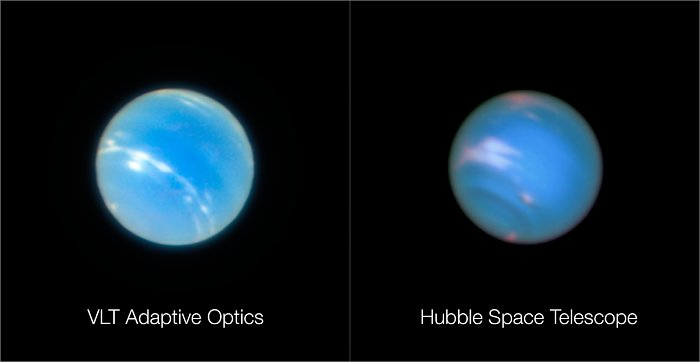SIGforum.com  Main Page
Main Page  The Lounge
The Lounge  Image of Neptune from ESO's Very Large Telescope rivals the Hubble Space Telescope
Image of Neptune from ESO's Very Large Telescope rivals the Hubble Space Telescope
 Main Page
Main Page  The Lounge
The Lounge  Image of Neptune from ESO's Very Large Telescope rivals the Hubble Space Telescope
Image of Neptune from ESO's Very Large Telescope rivals the Hubble Space TelescopeGo  | New  | Find  | Notify  | Tools  | Reply  |  |
| Nature is full of magnificent creatures |
We should be in for some spectacular new images once they get this going for real. This is a test image of Neptune:  https://www.nbcnews.com/mach/s...new-rival-ncna893996 Scientists have upgraded one of Earth’s most powerful telescopes to help it compensate for the atmospheric light-scattering that can make photos taken by ground-based telescopes appear blurry — and stunning new images of star clusters and Neptune show just how sharp such photos can now be. Before the upgrade, photos of Neptune taken by the European Southern Observatory’s Very Large Telescope (VLT) in Chile’s Atacama Desert showed the planet as a fuzzy blue spot. In the new photo, it appears as a blue disk with subtle color shadings and sharply defined edges. You can even see evidence of cloud activity on the planet’s shiny surface. The photos are so crisp that they rival those taken by the Hubble Space Telescope. “I have used the Hubble telescope on Neptune numerous times, and these images are every bit as sharp,” astronomer Mark Showalter, a senior research scientist at the SETI Institute in Mountain View, California, told NBC News MACH in an email. “If they’ve turned the VLT into a second Hubble, then we can all do more cutting-edge astronomy.” Over the past three decades, Hubble has captured some of astronomy’s most iconic images from its orbital perch high above Earth’s atmosphere — but it's able to accommodate only a fraction of the astronomers who would like to use it. VLT’s new capability was made possible by the addition of the Multi-Unit Spectroscopic Explorer (MUSE), an instrument that helps correct "atmospheric blur" using a technique known as adaptive optics. Light from celestial objects scatters as it collides with air molecules in Earth's atmosphere on its way to our vantage point on the planet's surface. Along with other instruments on the telescope, MUSE corrects these distortions by shooting laser beams into the sky to create “artificial stars” and then measuring how light from the faux stars is distorted. The telescope’s thin, deformable mirror compensates by shifting its shape 1,000 times a second to correct the distorted light. Of course, one good image of Neptune is just the beginning. Once it’s fully dialed in, the upgraded telescope will be used to study all sorts of celestial objects, including stars, supermassive black holes and supernovas as well as other planets and their moons — all in unprecedented detail. | ||
|
| Member |
does anyone spend more money than N.A.s.A. ? to get more like's ? cheese and crakers Safety, Situational Awareness and proficiency. Neck Ties, Hats and ammo brass, Never ,ever touch'em w/o asking first | |||
|
| Freethinker |
One of the (few) advantages of being old is being able to remember things like the first discussions of “adaptive optics” in the scientific literature. I have always been agnostic about the first announcements of such scientific breakthroughs, but I remember thinking of this, “Really? Are you serious in believing that such an idea would work?” Amazing stuff. ► 6.0/94.0 To operate serious weapons in a serious manner. | |||
|
| Nature is full of magnificent creatures |
About when did you first see this appear in the literature? I wonder how long it took between when it was first mentioned and the test image released in the link above. | |||
|
| Freethinker |
Not being a professional scientist, I can’t recall when I first saw it. It seems to me it was at least 10 years ago, though. Also, this isn’t the first time I’ve seen practical results from adaptive optics. This is evidently being heralded now because it’s an upgrade to an existing telescope, not that it’s a first for AO. I would guess that due to the size of the telescope it’s achieved a new level of resolution. ► 6.0/94.0 To operate serious weapons in a serious manner. | |||
|
Ammoholic |
Been 20+ years, also not the first to be adapted to adaptive optics. https://en.wikipedia.org/wiki/Magellan_Telescopes https://www.universetoday.com/...-for-the-first-time/ Jesse Sic Semper Tyrannis | |||
|
| Nature is full of magnificent creatures |
The next five years should bring amazing discoveries, with the James Webb telescope to be launched in three years or so and several new very large array telescopes due to be built in the southern hemisphere. | |||
|
| Political Cynic |
they are doing really neat things with adaptive optics at Kitt Peak and the 4.2m scope [B] Against ALL enemies, foreign and DOMESTIC | |||
|
| Powered by Social Strata |
| Please Wait. Your request is being processed... |
|
SIGforum.com  Main Page
Main Page  The Lounge
The Lounge  Image of Neptune from ESO's Very Large Telescope rivals the Hubble Space Telescope
Image of Neptune from ESO's Very Large Telescope rivals the Hubble Space Telescope
 Main Page
Main Page  The Lounge
The Lounge  Image of Neptune from ESO's Very Large Telescope rivals the Hubble Space Telescope
Image of Neptune from ESO's Very Large Telescope rivals the Hubble Space Telescope© SIGforum 2025